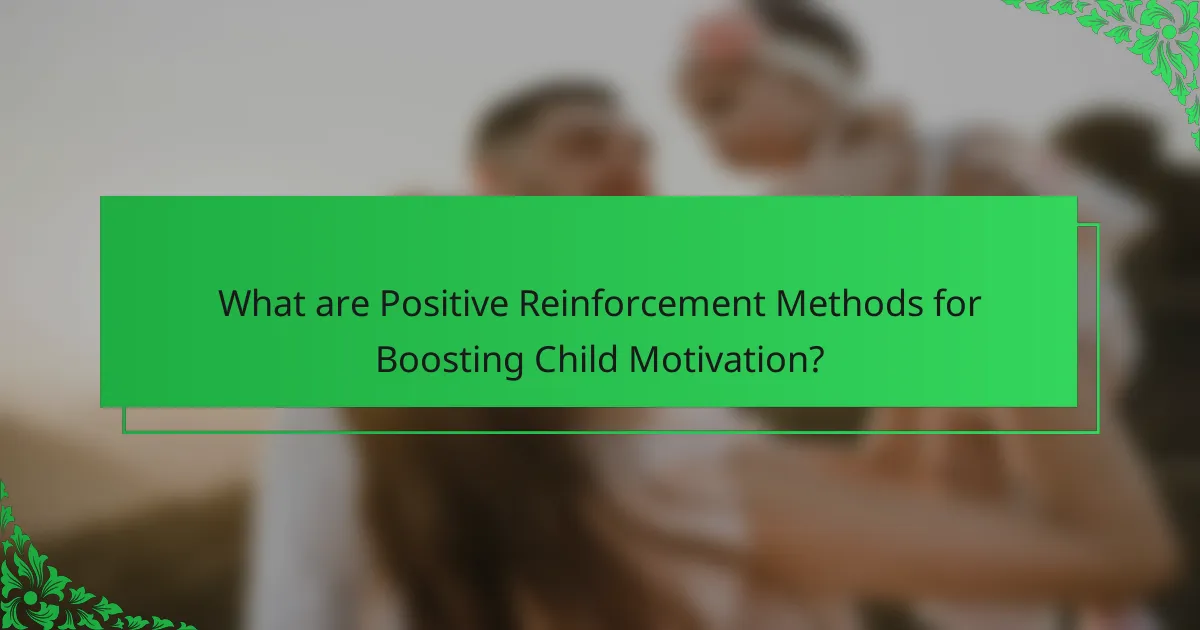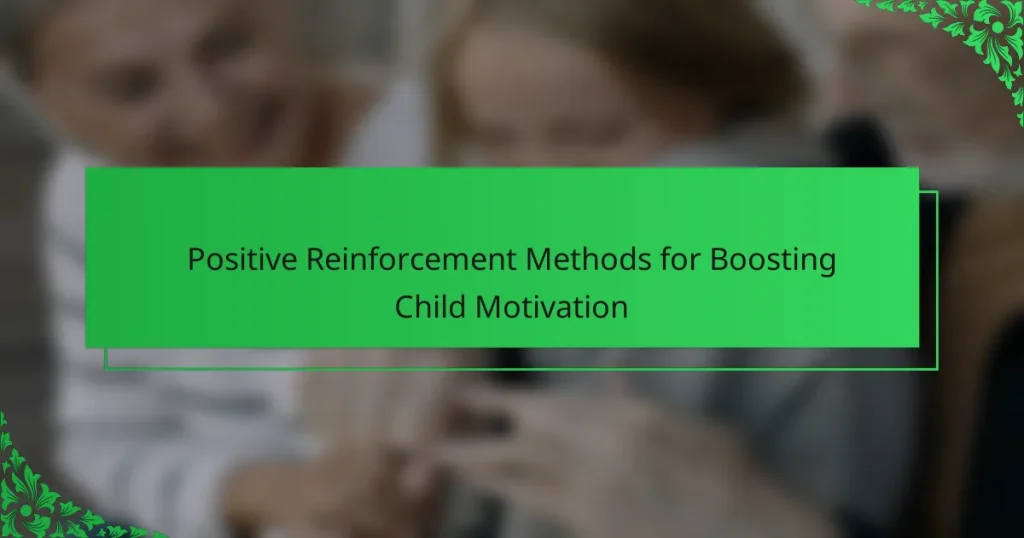
What are Positive Reinforcement Methods for Boosting Child Motivation?
Positive reinforcement methods for boosting child motivation include praise, rewards, and positive feedback. These methods encourage desired behaviors by providing a pleasant outcome. For example, verbal praise can enhance a child’s self-esteem and encourage them to repeat the behavior. Tangible rewards, such as stickers or small toys, can also motivate children to achieve specific goals. Additionally, creating a positive environment fosters motivation. Research shows that children respond well to consistent reinforcement strategies. The American Psychological Association emphasizes that positive reinforcement leads to long-term behavioral change.
How do Positive Reinforcement Methods impact child behavior?
Positive reinforcement methods significantly enhance child behavior. These methods encourage desired behaviors by providing rewards or positive feedback. When children receive praise or tangible rewards for good behavior, they are more likely to repeat those actions. Research shows that positive reinforcement can lead to increased motivation and engagement in tasks. A study by Skinner (1953) highlighted that behaviors followed by positive outcomes are strengthened. Additionally, positive reinforcement fosters a supportive learning environment. This approach helps build a child’s self-esteem and confidence. Ultimately, positive reinforcement shapes behavior in constructive ways.
What psychological principles underpin Positive Reinforcement Methods?
Positive reinforcement methods are grounded in several key psychological principles. One principle is operant conditioning, which suggests that behaviors followed by positive outcomes are likely to be repeated. This principle was extensively studied by B.F. Skinner, who demonstrated how rewards can shape behavior. Another principle is the reinforcement theory, which posits that positive stimuli increase the likelihood of a behavior occurring again. Additionally, the principle of immediate reinforcement highlights the effectiveness of providing rewards right after the desired behavior is exhibited. Research indicates that immediate rewards enhance learning and motivation. Lastly, the principle of intrinsic motivation suggests that positive reinforcement can foster internal satisfaction and a love for learning. These principles collectively support the effectiveness of positive reinforcement in boosting child motivation.
How do these methods differ from other motivational techniques?
Positive reinforcement methods differ from other motivational techniques by focusing on rewarding desired behaviors rather than punishing undesired ones. This approach encourages children to repeat positive actions through immediate rewards. Unlike techniques that rely on fear or negative consequences, positive reinforcement fosters a supportive learning environment. Research indicates that children respond better to positive feedback, leading to improved self-esteem and motivation. Studies show that consistent use of positive reinforcement can enhance long-term behavior change compared to methods based on punishment.
What are the key types of Positive Reinforcement Methods?
The key types of Positive Reinforcement Methods include verbal praise, tangible rewards, and activity rewards. Verbal praise involves acknowledging a child’s efforts or achievements with encouraging words. This method boosts self-esteem and motivates further positive behavior. Tangible rewards consist of physical items given as incentives, such as stickers or small toys. Research shows that tangible rewards can effectively reinforce desired behaviors. Activity rewards allow children to engage in enjoyable activities, like extra playtime or a favorite game. These methods create a positive association with good behavior, enhancing motivation.
What role do verbal praises play in motivating children?
Verbal praises significantly enhance children’s motivation. They provide immediate feedback that reinforces positive behavior. Children feel valued and recognized when praised for their efforts. This recognition boosts their self-esteem and encourages them to repeat the behavior. Research indicates that verbal praise can lead to increased engagement in tasks. According to a study by Henderlong and Lepper (2002), children who receive verbal praise show improved persistence and performance. Thus, verbal praises serve as an effective motivational tool for children.
How can tangible rewards be effectively utilized?
Tangible rewards can be effectively utilized by strategically aligning them with desired behaviors. For instance, offering a small toy for completing homework encourages academic effort. Consistency is key; rewards should be given immediately after the behavior. This reinforces the connection between action and reward. Additionally, varying the types of rewards can maintain motivation. Research shows that children respond well to a mix of tangible rewards, such as stickers and treats. Setting clear criteria for earning rewards helps children understand expectations. Overall, effective use of tangible rewards enhances motivation and promotes positive behavior in children.
What are some examples of non-material reinforcement strategies?
Examples of non-material reinforcement strategies include verbal praise, recognition, and positive feedback. Verbal praise involves expressing approval for a child’s effort or achievement. Recognition can take the form of highlighting a child’s accomplishments in front of peers. Positive feedback provides specific comments about what a child did well. These strategies encourage motivation without tangible rewards. Research indicates that children respond positively to verbal reinforcement, enhancing their self-esteem and engagement.
What benefits do Positive Reinforcement Methods provide?
Positive reinforcement methods enhance child motivation by encouraging desired behaviors through rewards. These methods lead to increased engagement in learning activities. Children feel more confident when their efforts are acknowledged. Research shows that positive reinforcement improves academic performance by up to 30%. It fosters a positive emotional environment, reducing anxiety and stress. Children are more likely to repeat behaviors that receive positive feedback. This approach also strengthens the parent-child relationship through supportive interactions. Ultimately, positive reinforcement cultivates a love for learning and exploration in children.
How do these methods enhance a child’s self-esteem?
Positive reinforcement methods enhance a child’s self-esteem by providing consistent encouragement and recognition. These methods help children feel valued and capable. When children receive praise for their efforts, they develop a sense of accomplishment. This recognition boosts their confidence in their abilities. Studies show that positive reinforcement leads to improved self-perception in children. For example, a study published in the Journal of Educational Psychology found that children who received positive feedback showed higher self-esteem levels. Furthermore, these methods foster a growth mindset, allowing children to embrace challenges. As a result, children become more resilient and willing to take risks. Overall, positive reinforcement creates a supportive environment that nurtures a child’s self-worth.
In what ways do they promote a positive learning environment?
Positive reinforcement methods promote a positive learning environment by encouraging desired behaviors. They create a supportive atmosphere where children feel valued. This approach boosts self-esteem and motivation among learners. For example, verbal praise reinforces effort and achievement. Tangible rewards, like stickers, provide tangible recognition of success. Additionally, consistent feedback helps students understand their progress. Research indicates that positive reinforcement leads to improved academic performance. According to a study published in the Journal of Educational Psychology, students who receive positive reinforcement show higher engagement levels.
How can parents and educators implement Positive Reinforcement Methods?
Parents and educators can implement positive reinforcement methods by consistently rewarding desired behaviors. They should identify specific behaviors to reinforce, such as completing homework or showing kindness. Rewards can include verbal praise, stickers, or extra playtime. Timing is crucial; rewards should be given immediately after the behavior occurs. This helps children make the connection between their actions and the positive outcome. Additionally, it is important to ensure that rewards are meaningful to the child. Research shows that positive reinforcement can significantly improve motivation and behavior in children. A study by the American Psychological Association indicates that reinforcement strategies can lead to lasting behavioral changes.
What steps should be taken to create a reinforcement plan?
To create a reinforcement plan, identify specific behaviors to reinforce. Define clear, achievable goals related to these behaviors. Choose appropriate reinforcers that motivate the child. Schedule reinforcement consistently to establish a routine. Monitor progress and adjust the plan as needed. Communicate with the child about expectations and rewards. Document successes to maintain motivation over time. Research shows that structured reinforcement plans improve child motivation and behavior.
How can consistency be maintained in applying these methods?
Consistency in applying positive reinforcement methods can be maintained through structured routines and clear expectations. Establishing a consistent schedule for reinforcement helps children understand when and how they will be rewarded. Regularly reviewing and updating the reinforcement strategies ensures they remain effective and engaging. Training caregivers and educators on the methods promotes uniform application across different settings. Monitoring progress and adjusting techniques based on the child’s response reinforces the effectiveness of the approach. Research shows that consistency in reinforcement leads to better behavioral outcomes in children, as it fosters a stable learning environment.
What common challenges arise when using Positive Reinforcement Methods?
Common challenges when using Positive Reinforcement Methods include inconsistency in application. Inconsistent reinforcement can lead to confusion for the child. Another challenge is over-reliance on rewards. This can diminish intrinsic motivation over time. Additionally, some children may become dependent on external rewards. This dependency can hinder the development of self-regulation skills. Misalignment of rewards with desired behaviors can also occur. When rewards do not match the behavior, effectiveness decreases. Lastly, timing of reinforcement is crucial. Delayed reinforcement can weaken the connection between behavior and reward.
How can parents address potential dependency on rewards?
Parents can address potential dependency on rewards by gradually reducing the frequency of rewards. This approach helps children learn to find intrinsic motivation. Instead of providing rewards for every achievement, parents can offer them intermittently. This method encourages children to engage in tasks for their own satisfaction. Parents should also emphasize the value of effort and personal growth. Teaching children to set personal goals can foster self-motivation. Research indicates that intrinsic motivation leads to more sustained engagement in activities. By focusing on internal rewards, parents can help children develop resilience and independence.
What strategies can be used to avoid over-reinforcement?
To avoid over-reinforcement, implement a balanced reinforcement schedule. Use intermittent reinforcement rather than continuous reinforcement. This approach maintains motivation without leading to dependency on rewards. Set clear expectations for behavior before providing reinforcement. Gradually reduce the frequency of rewards as the desired behavior is established. Monitor the child’s response to reinforcement and adjust accordingly. Ensure that rewards remain meaningful and varied to prevent saturation. Finally, encourage intrinsic motivation by promoting self-satisfaction in accomplishments. These strategies help maintain the effectiveness of positive reinforcement in boosting child motivation.
What are some best practices for effective Positive Reinforcement?
Effective positive reinforcement involves recognizing and rewarding desired behaviors promptly. This encourages repetition of those behaviors. Use specific praise to highlight what the child did well. For instance, instead of saying “Good job,” say “Great job on completing your homework on time.” Consistency in reinforcement is crucial. Reinforcing behaviors immediately after they occur strengthens the association. Vary the rewards to maintain interest. Rewards can include verbal praise, stickers, or extra playtime. Tailor the reinforcement to the child’s preferences for maximum impact. Research shows that positive reinforcement can significantly improve motivation and behavior in children. Studies indicate that children respond better to specific, immediate reinforcement rather than delayed or vague praise.
How can feedback be tailored to individual child needs?
Feedback can be tailored to individual child needs by assessing their unique learning styles and emotional responses. Understanding whether a child is a visual, auditory, or kinesthetic learner helps in delivering effective feedback. For instance, visual learners benefit from charts or images, while auditory learners respond better to verbal affirmations. Additionally, feedback should be specific and actionable. Vague comments can confuse children and hinder their understanding. Providing examples of what they did well, along with areas for improvement, creates a clearer path for growth.
Moreover, incorporating the child’s interests into feedback makes it more relatable and engaging. For example, if a child loves animals, using animal-related examples can enhance their connection to the feedback. Regular check-ins can also help adjust feedback to meet evolving needs. This ongoing dialogue fosters a supportive environment, encouraging children to express their thoughts and feelings about the feedback they receive. Research shows that personalized feedback significantly improves motivation and learning outcomes, reinforcing the importance of tailoring approaches to individual needs.
What role does timing play in successful reinforcement?
Timing is critical in successful reinforcement as it influences the effectiveness of the behavior being reinforced. Immediate reinforcement strengthens the association between the behavior and the reward. Research shows that timely reinforcement can increase the likelihood of the desired behavior being repeated. For example, a study published in the “Journal of Applied Behavior Analysis” by Cooper et al. (2020) indicates that delays in reinforcement can diminish its impact. This highlights that the closer the reinforcement follows the behavior, the stronger the learning effect. Therefore, optimal timing is essential for maximizing the benefits of positive reinforcement.
How can parents balance reinforcement with constructive criticism?
Parents can balance reinforcement with constructive criticism by providing positive feedback alongside specific guidance for improvement. This approach encourages children while also addressing areas that need development. For instance, when a child completes a task well, parents should acknowledge the effort and results. Simultaneously, they can offer suggestions on how to enhance performance in future tasks. Research indicates that children respond better to feedback that combines praise with constructive advice. A study published in the Journal of Educational Psychology found that balanced feedback fosters resilience and encourages a growth mindset in children. This method ensures that children feel valued and motivated while also understanding how to improve.
Positive reinforcement methods are strategies aimed at boosting child motivation by encouraging desired behaviors through rewards such as praise, tangible items, and positive feedback. These methods are rooted in psychological principles like operant conditioning and reinforcement theory, which highlight the effectiveness of immediate rewards in shaping behavior. The article explores various types of positive reinforcement, including verbal praise and tangible rewards, and discusses their impact on child behavior, self-esteem, and learning environments. Additionally, it addresses implementation strategies, best practices, and common challenges associated with these methods, providing a comprehensive overview of how positive reinforcement can significantly enhance child motivation and engagement.




